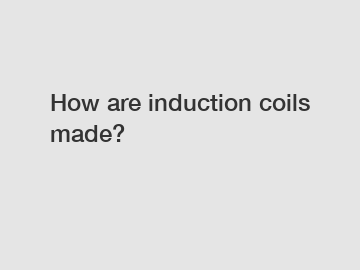How are induction coils made?
How are induction coils made? Explore the process and applications of this essential component in electrical engineering.
Induction coils play a vital role in various electrical devices and equipment. They are commonly used in transformers, generators, electromagnets, and high-frequency heating systems. But have you ever wondered how these coils are made? In this article, we will delve into the fascinating world of induction coil manufacturing, exploring the steps involved and their significance in different industries.
1. Understanding the basics of induction coils:

- An induction coil is typically composed of a cylindrical core made from a highly magnetic material, such as iron or ferrite.
- Copper wire is tightly wound around the core, creating multiple turns to form a coil.
- The ends of the wire are connected to a power source, allowing the flow of electrical current through the coil, generating a magnetic field.
2. Coiling and winding process:
- The coil winding process begins with selecting an appropriate core material. The choice of core material depends on factors such as application, frequency, and desired magnetic properties.
- The core is then prepared by cleaning and laminating it to reduce energy losses caused by eddy currents.
- Specialized winding machines are used to tightly wind the copper wire around the core. The number of turns and wire gauge are determined based on the specific application and desired electrical characteristics.
- The winding process requires precision and expertise to ensure uniformity and minimize electromagnetic interference.
3. Insulation and protection:
- Once the winding process is complete, several layers of insulation are applied to protect the coil and prevent short circuits. Common insulating materials include enamel, paper, and varnishes.
- Insulation also helps in maintaining the coil's shape and preventing abrasion between the wire and the core.
- Depending on the application, additional protective measures such as enclosures or epoxy resin coatings may be applied to safeguard the coil from environmental factors like moisture, dust, and vibration.
4. Testing and quality control:
- As with any electrical component, induction coils undergo rigorous testing to ensure they meet the required standards and specifications.
- The coils are tested for resistance, insulation resistance, inductance, and other electrical characteristics. These tests help identify any manufacturing defects, such as short circuits or faulty insulation.
- In advanced applications, specialized equipment like impedance analyzers and LCR meters may be used to measure and validate the coil's performance across different frequencies.
Induction coils find applications in a wide range of industries, from power generation to consumer electronics. Here are a few notable applications:
5. Power transformers:
- Induction coils are at the heart of power transformers, which play a critical role in power transmission and distribution networks.
- These coils help step up or step down the voltage levels, ensuring efficient and safe transmission of electricity.
- Their reliable and efficient operation is paramount for maintaining power quality and minimizing energy losses.
6. Electric motors and generators:
- Induction coils form an integral part of electric motors and generators, converting electrical energy into mechanical energy and vice versa.
- The coils rotate within a magnetic field, inducing current and generating the required magnetic force for motor rotation or electricity generation.
7. Induction heating systems:
- High-frequency induction heating systems utilize induction coils to generate heat in various industrial processes such as metal hardening, melting, and cooking appliances.
- The rapidly alternating magnetic field induces electrical currents in conductive materials, causing them to heat up due to electrical resistance.
In conclusion, the manufacturing of induction coils involves careful selection of core materials, precise winding techniques, insulation, and thorough quality control. These essential components find applications in power transformers, electric motors, generators, and induction heating systems, among others. Understanding the intricacies of induction coil manufacturing helps us appreciate their importance in powering our modern world. So, next time you turn on a device or benefit from electricity, reflect on the hidden marvels of the induction coils that make it all possible. How are induction coils made? It's a captivating tale of science, engineering, and innovation.
Contact us to discuss your requirements of china induction heat treating scanner factory, china Bar Induction Tempering Machine factory, china Chain Induction Hardening Equipment supplier. Our experienced sales team can help you identify the options that best suit your needs.
110
0
0


Comments
All Comments (0)